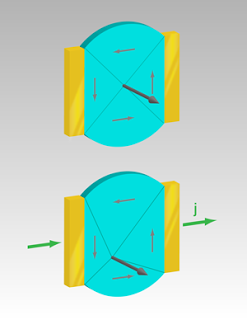Permalloy disk sample and contacts for current injection. (Top) Four 90° domain walls intersect at the vortex core with its out-of-plane magnetization. (Bottom) As current flows through the disk, the vortex core is displaced due to the magnetic field of the current and due to spin-transfer torque. This displacement has been measured to quantify the nonadiabatic part of spin torque.
Imagine a computer equipped with shock-proof memory that’s 100,000 times faster and consumes less power than current hard disks. EPFL Professor Mathias Klaui is working on a new kind of “racetrack” memory, a high-volume, ultra-rapid non-volatile read-write magnetic memory that may soon make such a creature possible.
Scientists at the Zurich Research Center of IBM (which is developing a racetrack memory) have confirmed the importance of the results in the Viewpoint article. Millions or even billions of nanowires would be embedded in a chip, providing enormous capacity on a shock-proof platform. A market-ready device could be available in as little as 5-7 years.
Racetrack memory promises to be a real breakthrough in data storage and retrieval. Racetrack-equipped computers would boot up instantly, and their information could be accessed 100,000 times more rapidly than with a traditional hard disk. They would also save energy. RAM needs to be powered every millionth of a second, so an idle computer consumes up to 300 mW just maintaining data in RAM. Because Racetrack memory doesn’t have this constraint, energy consumption could be slashed by nearly a factor of 300, to a few mW while the memory is idle
The bits of information stored in the wire are simply pushed around inside the tape using a spin polarized current, attaining the breakneck speed of several hundred meters per second in the process. Credit: IBM Almaden Research Center
We use a pump-probe photoemission electron microscopy technique to image the displacement of vortex cores in Permalloy discs due to the spin-torque effect during current pulse injection. Exploiting the distinctly different symmetries of the spin torques and the Oersted-field torque with respect to the vortex spin structure we determine the torques unambiguously, and we quantify the amplitude of the strongly debated nonadiabatic spin torque. The nonadiabaticity parameter is found to be β=0.15±0.07, which is more than an order of magnitude larger than the damping constant α, pointing to strong nonadiabatic transport across the high magnetization gradient vortex spin structures.
2. There is other interesting work towards graphene based spin computers. Physicists at the University of California, Riverside have taken an important step forward in developing a “spin computer” by successfully achieving “tunneling spin injection” into graphene.
If you liked this article, please give it a quick review on ycombinator, or Reddit, or StumbleUpon. Thanks
Featured articles
Ocean Floor Gold and Copper
Ocean Floor Mining Company

Brian Wang is a Futurist Thought Leader and a popular Science blogger with 1 million readers per month. His blog Nextbigfuture.com is ranked #1 Science News Blog. It covers many disruptive technology and trends including Space, Robotics, Artificial Intelligence, Medicine, Anti-aging Biotechnology, and Nanotechnology.
Known for identifying cutting edge technologies, he is currently a Co-Founder of a startup and fundraiser for high potential early-stage companies. He is the Head of Research for Allocations for deep technology investments and an Angel Investor at Space Angels.
A frequent speaker at corporations, he has been a TEDx speaker, a Singularity University speaker and guest at numerous interviews for radio and podcasts. He is open to public speaking and advising engagements.



